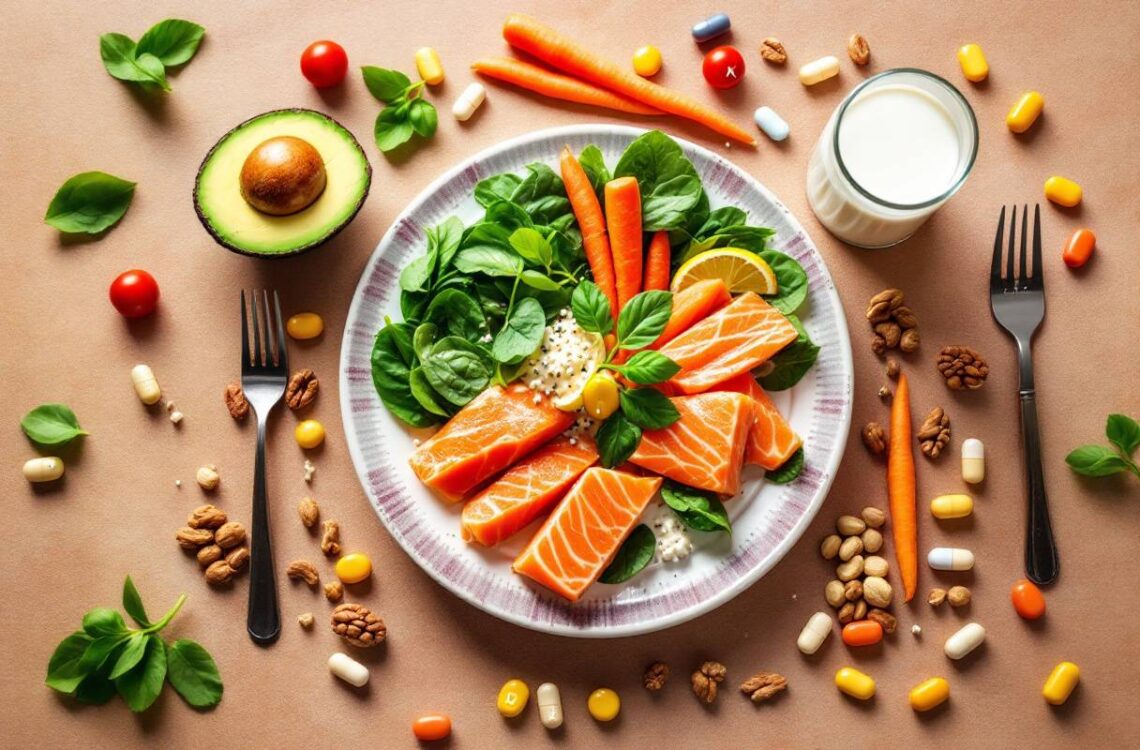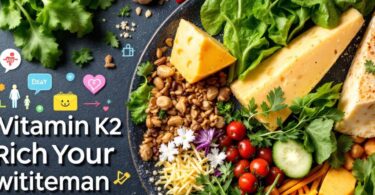Are you ready to unlock the secret superpowers hidden in your favorite foods? Welcome to the fascinating world of fat-soluble vitamins – the unsung heroes of your body’s health and vitality.
These nutrient ninjas, comprising vitamins A, D, E, and K, don’t just pass through your system; they stick around, nestling in your fatty tissues and liver, ready to spring into action when you need them most. From keeping your vision sharp to building strong bones and even acting as your body’s personal bodyguards, these essential nutrients are the key players in maintaining your
overall well-being. So, buckle up as we embark on a flavorful journey through the realm of fat-soluble vitamins, discovering how these mighty molecules can fuel your health and transform your diet into a powerhouse of nutrition!
Introduction to Fat-Soluble Vitamins
Fat-soluble vitamins are like the VIPs of the nutrition world, hanging out in your body’s fatty parts and the liver, ready to swoop in with their superpowers whenever you need them. Unlike their water-soluble buddies, these vitamins stick around longer because they chill in fat cells.
What are Fat-Soluble Vitamins?
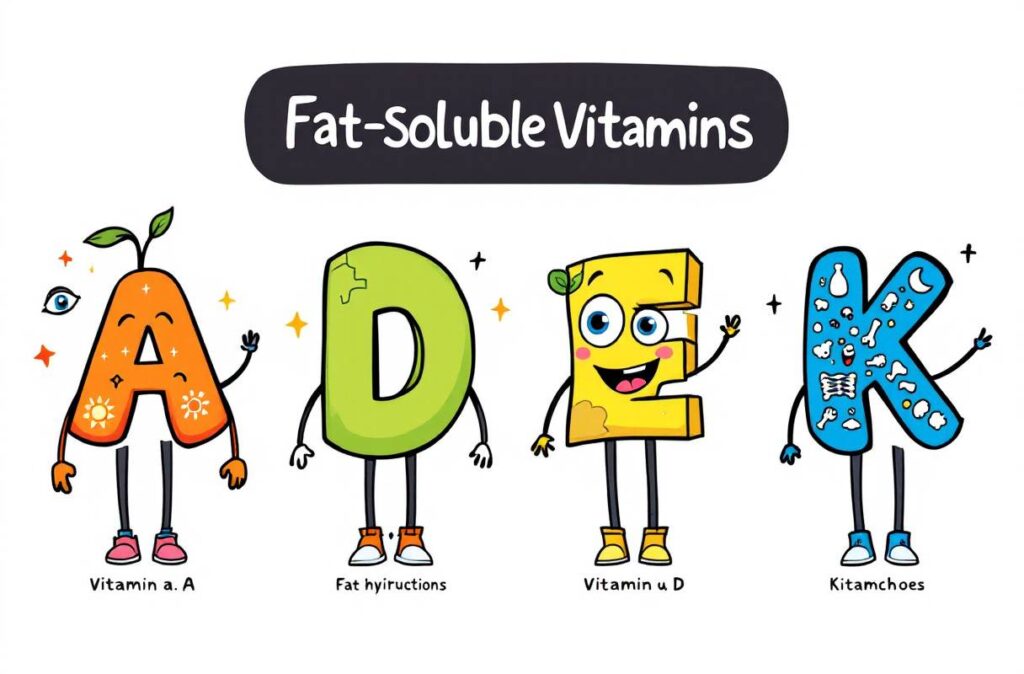
Think of fat-soluble vitamins as the “fat-friendly” crew. They dissolve in fats and oils, tagging along for the ride with dietary fats into your body’s cushiest seats—adipose tissues and the liver. This means you don’t have to be munching on them every day. The fab four in this group are:
- Vitamin A
- Vitamin D
- Vitamin E
- Vitamin K
| Fat-Soluble Vitamin | Primary Function | Main Sources |
|---|---|---|
| Vitamin A | Keeps your peepers and immune system sharp | Carrots, sweet potatoes, spinach |
| Vitamin D | Bone builder and calcium helper | Sunlight, fortified milk, fatty fish |
| Vitamin E | Guardian of cells and skin caretaker | Almonds, sunflower seeds, spinach |
| Vitamin K | Blood-clotting champ and bone strengthener | Kale, broccoli, Brussels sprouts |
Want to score big on these nutrients? Knowing what they do can make all the difference.
Importance of Fat-Soluble Vitamins for Health
These vitamins aren’t just sitting pretty—they’re your body’s all-star health team.
Vitamin A: Eyes, skin, and defense system keep this vitamin at the top of the charts. It’s a parent’s secret weapon for helping kids grow strong and healthy.
Vitamin D: The quintessential bone buddy, working to boost calcium absorption. If you’re short on sunshine, or over a certain age, better keep an eye on this one. Curious about the best vitamin D supplements? We’ve got you covered.
Vitamin E: With its role as a superhero to your cells, it fights off the baddies. It’s also in your corner for glowing skin and strong eyes. Fitness fanatics can thank it for supporting muscle health.
Vitamin K: The clot maker, responsible for curbing excessive bleeding and playing a role in bone metabolism. Interested in how Vitamin K2 shakes it up? Our vitamin K2 benefits article has the scoop.
Tuning into these vitamins ensures that your diet isn’t missing out on what your body craves. If you’re the curious type, there’s even more about these power-packed nutrients in our essential vitamins and minerals guide.
Fat-soluble vitamins are critical for maintaining health and preventing disease. They play key roles in processes ranging from vision and bone metabolism to immune function and blood clotting.
Dr. Walter Willett, Professor of Epidemiology and Nutrition at Harvard T.H. Chan School of Public Health
Vitamin A
Vitamin A is one heck of an important little nutrient. It’s like the Swiss army knife of vitamins, keeping everything from your peepers sharp to your immune system in fighting form. Getting the low-down on this vitamin and where to find it can steer you towards smarter eating choices.
Functions and Sources of Vitamin A
Vitamin A has its fingers in many pies when it comes to keeping your body running smoothly:
- Vision: Your eyes are basically addicted to Vitamin A. It’s a superstar player in rhodopsin, that magical protein making sure you don’t bump into walls.
- Immune System: Vitamin A is the unsung bodyguard, keeping your skin and mucous membranes tough so nasties can’t just waltz in.
- Cell Growth: Picture Vitamin A as the foreman at a construction site, making sure your organs are built right and ready for action.
- Skin Health: Ever wonder why your skin stays somewhat smooth? Thank this little gem for keeping those outer layers regenerating.
You can snag Vitamin A in two main forms: Retinoids (think steak and eggs) and Carotenoids (your carrot sticks and kale munchies).
| Source Type | Food Sources |
|---|---|
| Retinoids | Liver, Fish oils, Dairy products, Eggs |
| Carotenoids | Carrots, Sweet potatoes, Spinach, Kale, Red peppers |
Craving more about those vital nutrients? Peek at our essential vitamins and minerals article!
Recommended Daily Intake of Vitamin A
How much Vitamin A is enough is a bit of a math game. It varies by age and gender, and it’s measured in micrograms of retinol activity equivalents (RAE), which combines both forms.
| Age Group | Recommended Daily Intake (RAE) |
|---|---|
| Infants (0-6 months) | 400 mcg |
| Infants (7-12 months) | 500 mcg |
| Kids (1-3 years) | 300 mcg |
| Kids (4-8 years) | 400 mcg |
| Boys (9-13 years) | 600 mcg |
| Girls (9-13 years) | 600 mcg |
| Men (14+) | 900 mcg |
| Women (14+) | 700 mcg |
| Moms-to-Be Teens | 750 mcg |
| Moms-to-Be | 770 mcg |
| Nursing Teens | 1,200 mcg |
| Nursing Women | 1,300 mcg |
Stick to these numbers to keep from swinging into deficiency or overdose. Need help picking a multivitamin? Check out our how to choose multivitamin guide.
Eating a balanced mix of critters and greens will hit those Vitamin A targets and keep you feeling your best.
Vitamin D
Importance of Vitamin D for Bone Health
Vitamin D is kind of like the unsung hero for your bones’ well-being. This fat-soluble buddy helps the body soak up calcium, which is the backbone of—well, your bones! Without enough of this vitamin, your skeleton could turn wobbly—thin, fragile, or even misshapen.
Too little vitamin D can set the stage for serious stuff like rickets in kiddos and osteoporosis in adults. Plus, this vitamin keeps muscles and your immune system in fighting shape, making it a superstar in the nutrition lineup.
Sources of Vitamin D and Sun Exposure
Catching some rays is a stellar way to boost your vitamin D. When UVB rays from the sun hit your skin, they kickstart the production of vitamin D. Spending just a smidge of your day under the sun can top up your levels.
Besides basking in the sun, you can score vitamin D from munching on certain foods and popping dietary supplements. Here’s a quick peek at some go-to sources:
| Source | Vitamin D Content (IU) |
|---|---|
| A sunny stroll (10-30 mins) | Varies (600 – 800 IU) |
| Salmon (3.5 Oz) | 360 IU |
| Cod Liver Oil (1 tsp) | 450 IU |
| Egg Yolk (1 large) | 40 IU |
| Fortified Milk (1 cup) | 120 IU |
| Fortified Orange Juice (1 cup) | 100 IU |
If you’re not soaking up much sun or you’re on a vegan path, vitamin D supplements might be worth a look. Got the curiosity bug? Check out our piece on best vitamin D supplements.
Getting the lowdown on vitamin D’s bone perks and where to snag it can help you keep your levels just right, ensuring your bones stay solid and life rolls smooth. Curious how calcium and vitamin D play together? Dive into our piece on calcium vs vitamin D.
Vitamin E
Antioxidant Powers of Vitamin E
Vitamin E is like the superhero of antioxidants, keeping those pesky free radicals from causing chaos in your body. It’s the reason your cells, proteins, and even DNA can breathe a sigh of relief. Less oxidative stress means you might dodge a few chronic illness bullets. Among the eight forms of vitamin E, alpha-tocopherol is the head honcho, especially when it comes to supplements. It’s not just about fighting radicals; this vitamin is your skin’s best friend, boosts your immune system, and helps keep inflammation in check.
Foods Packed with Vitamin E
Want to make sure you’re getting your Vitamin E fix? Here’s where you can find it:
| Food Source | Vitamin E Content (mg per 100g) |
|---|---|
| Sunflower Seeds | 35.17 |
| Almonds | 25.63 |
| Hazelnuts | 15.03 |
| Pine Nuts | 9.33 |
| Spinach | 2.03 |
| Avocado | 2.07 |
| Olive Oil | 14.35 |
| Red Bell Peppers | 1.58 |
Think oils, nuts, seeds, and the green stuff. Mix them up in your meals to snag enough of this fat-friendly vitamin. Especially if you’re all about that plant-based life! These foods are your golden ticket to keeping your vitamin E levels up.
If you’re curious about other essential vitamins and minerals, you can check out our piece on important vitamins and minerals. Thinking about popping a vitamin E pill? We’ve got the scoop on top vitamin E supplements you can read for more details.
Keeping a diet full of these goodies means you’re well on your way to hitting those vitamin E targets and staying healthy.
Vitamin K
Vitamin K’s got your back! It’s the go-to nutrient when it comes to keeping your blood clotting game on point and your bones strong as steel. There’re two sides to this vitamin wonder, and they both play their part in keeping you feeling your best. Let’s break it down!
Role of Vitamin K in Blood Clotting
Ever wonder how your body stops those pesky cuts from turning into a full-blown horror show? Thank Vitamin K! It’s the hero behind the scenes making sure your blood coagulates properly. If you ever cut yourself shaving, or nick your finger slicing vegetables, the quick stop to bleeding is often Vitamin K’s magic at work. Without enough of it, your body struggles to seal up those wounds, and nobody wants to walk around like a leaky faucet.
Functions of Vitamin K in Blood Clotting
- Fires up the important players: factors II, VII, IX, and X
- Helps these factors cozy up to calcium
- Makes sure the blood clotting chain reaction goes off without a hitch
| Function | Description |
|---|---|
| Round-Up of Factors | Gets II, VII, IX, X up and running |
| Calcium Connection | Ensures calcium knows where to lend a hand |
| Clotting Command Center | Organizes a smooth clotting process |
Different Forms of Vitamin K and Food Sources
The Vitamin K family has a couple of stars: Vitamin K1 and Vitamin K2. They both kick in with their unique roles in keeping your body in check.
Vitamin K1 (Phylloquinone)
Veggie-lover? You’ll find Vitamin K1 lounging around in your salad bowl. It’s mostly chilling in green veggies, doing its thing to make sure your blood’s good to go.
| Food Source | Vitamin K1 Content (µg per 100g) |
|---|---|
| Kale | 817 |
| Spinach | 482 |
| Broccoli | 141 |
| Brussels sprouts | 140 |
Vitamin K2 (Menaquinone)
Vitamin K2’s the globetrotter, hanging out in animal produce and fermented goodies. It’s got your bone and heart routine covered and even flexes with its subtypes—MK-4 and MK-7, to name a couple.
| Food Source | Vitamin K2 Content (µg per 100g) |
|---|---|
| NATO (fermented soybeans) | 1103 |
| Chicken Liver | 14 |
| Hard Cheeses | 76 |
| Egg Yolk | 32 |
Got a thirst for knowledge? For the full scoop on vitamins and why they’re vital, dive into our piece on essential vitamins and minerals. If Vitamin K2’s got your attention, we spill more on its perks in our article on vitamin k2 benefits.
Remember, both versions of Vitamin K are your body’s sidekicks in keeping you healthy. So, load up your plate with these Vitamin K-packed foods and give your wellbeing the boost it deserves. Want to figure out which multivitamin fits your groove? Check out our guide on how to choose multivitamin.
Absorption and Storage of Fat-Soluble Vitamins
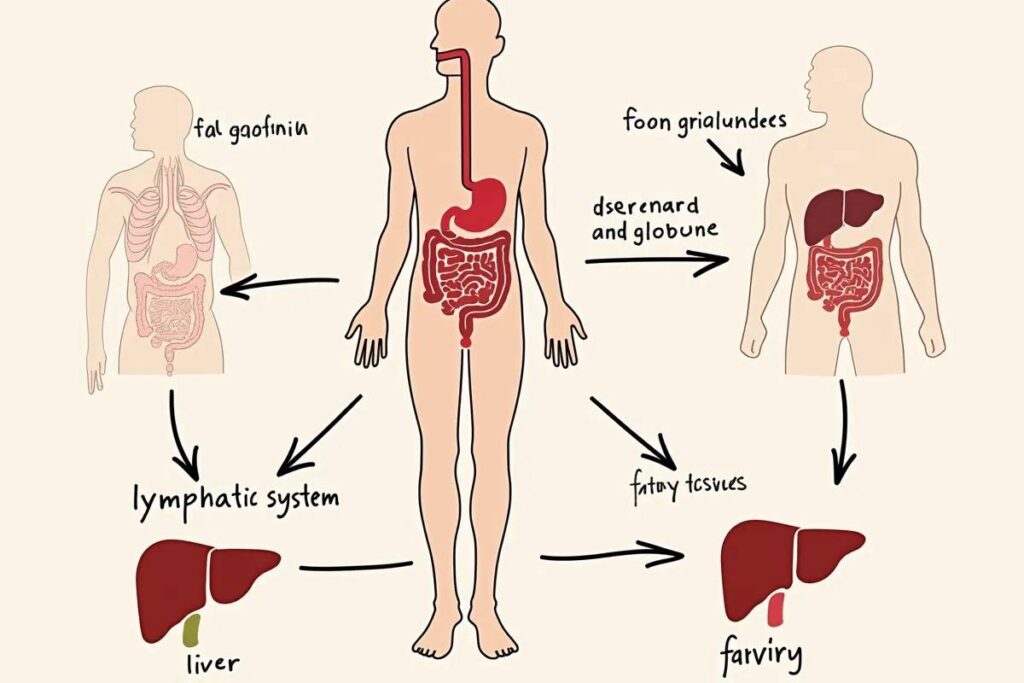
So, you’ve got your eye on staying healthy, right? Well, let’s get to the nitty-gritty about how those fat-soluble vitamins—A, D, E, and K—make their way into your system and hang around. They ride on the coattails of dietary fats, making them pretty unique compared to their water-loving counterparts. This isn’t just trivia; it’s a big deal for your health.
The absorption of fat-soluble vitamins is intrinsically linked to dietary fat intake. This relationship underscores the importance of including healthy fats in our diets to ensure optimal vitamin absorption and utilization.
Dr. Michael F. Horlick, Professor of Medicine, Physiology and Biophysics at Boston University School of Medicine
How Fat-Soluble Vitamins are Absorbed
These vitamins are like hitchhikers in the gut, grabbing a ride with fats you eat. When you munch on foods packed with these vitamins, they’re scooped up into tiny fat droplets called micelles. These little guys are key because they sneak the vitamins into your intestinal cells.
Once inside, these vitamins don’t stop there. They’re bundled up into chylomicrons—basically tiny packages that shuttle them through the lymphatic system before they finally spill into the bloodstream. Think of it like getting on multiple buses to reach the right stop. From there, the vitamins find their way to different parts of the body, with the liver and body’s fat being their favorite hangout spots.
Key stops along the way:
- Micelle formation in the gut
- Sneaking into intestinal cells
- Getting packed into chylomicrons
- A ride through the lymphatic system
- Hopping into the bloodstream
Importance of Proper Fat Intake for Absorption
Here’s the scoop: no fats, no ride for these vitamins. Without enough fat in your diet, these vitamins miss their bus and don’t get absorbed. This could lead to gaps in your vitamin levels, something folks on low-fat diets should totally watch out for.
Craving good absorption means pairing these vitamins with healthy fats. Think avocados, nuts, seeds, and olive oil—tasty and smart. By mixing in some variety in your diet, you’ll keep your vitamin levels in check.
| Vitamin | How Much You Need | Where to Find It | Needs Fat? |
|---|---|---|---|
| Vitamin A | 900 mcg (men), 700 mcg (women) | Carrots, sweet potatoes, spinach | You bet! |
| Vitamin D | 600 IU (adults) | Fortified milk, fatty fish, sunny days | Absolutely! |
| Vitamin E | 15 mg | Nuts, seeds, leafy greens | Yes, indeed! |
| Vitamin K | 120 mcg (men), 90 mcg (women) | Kale, broccoli, Brussels sprouts | Yep! |
Knowing how these vitamins work in your body can really help you nail down a healthy diet. Curious about other nutrients? Check out articles on essential vitamins and minerals and how to choose multivitamin. Balancing these vitamins with the right fats is a big step toward feeling your best and staying on top of your health game.
Deficiency and Toxicity of Fat-Soluble Vitamins
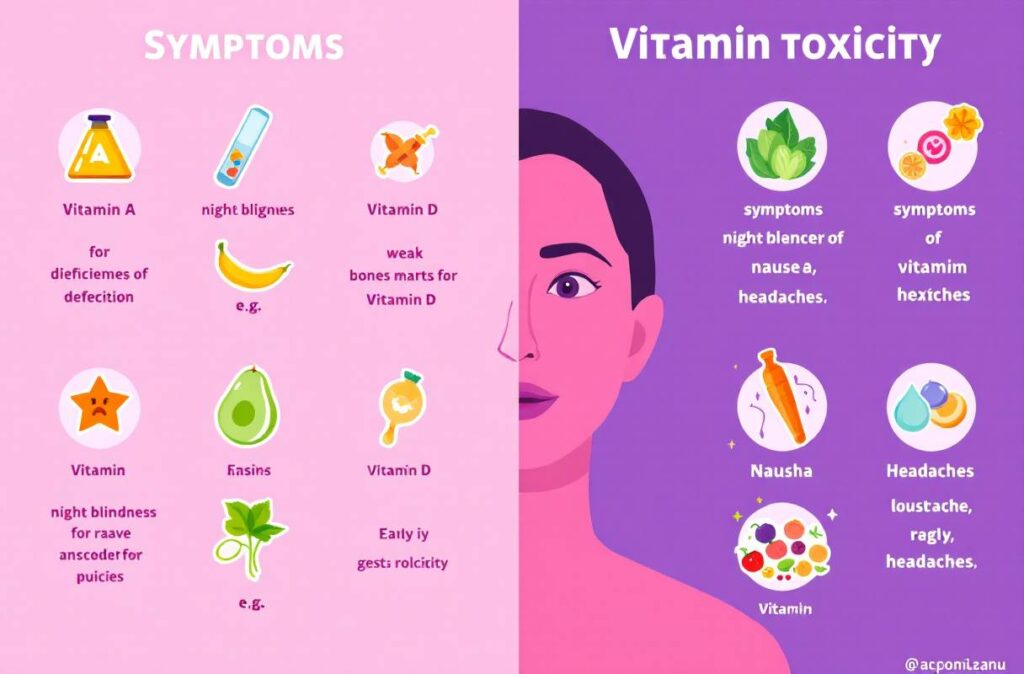
When it comes to fat-soluble vitamins, you really want to get the balance just right. Too little and you’re asking for trouble; too much, and you’re in a different kind of hot water. So, why should you care? Because your well-being depends on it.
Symptoms of Fat-Soluble Vitamin Deficiencies
Let’s talk about what happens when you don’t get enough of these vitamins—A, D, E, and K. It ain’t pretty, folks.
| Vitamin | Deficiency Symptoms |
|---|---|
| Vitamin A | Struggling to see in the dark, desert-like eyes, catching every bug and skin not looking its best |
| Vitamin D | Achy bones, weak muscles, feeling more breakable than a dropped egg, always tired |
| Vitamin E | Wobbly muscles, blurry vision, and your immune system throwing in the towel |
| Vitamin K | Bruise like a ripe banana, bleeding like it’s going out of style, surprising blood in places it shouldn’t be |
Risks of Excessive Fat-Soluble Vitamin Consumption
Now, you think you’re safe by loading up, right? Not so fast. Fat-soluble vitamins have a way of camping out in your body’s fat, ready to spill over to toxicity if you overdo it.
| Vitamin | Toxicity Symptoms |
|---|---|
| Vitamin A | Spinning rooms, feeling queasy, head pounding, flaky skin, liver waving a red flag |
| Vitamin D | Too much calcium in the places you really don’t need it, like an endless bathroom tour, nausea, and weakness |
| Vitamin E | Bleeding risks go up, your blood might not behave, suddenly lacking energy |
| Vitamin K | Baby jaundice surprises, blood cell troubles, throwing off meds that keep the blood flowing right |
Getting these vitamins in the right amounts keeps you in the game and feeling good. If you’re wondering how to juggle these nutrients, check out our essential vitamins and minerals guide.
Keeping tabs on your vitamin intake isn’t just about avoiding illness; it’s about keeping in tip-top shape. Don’t just wing it; talk to the pros like dietitians or doctors to figure out what’s best for you. Your health will thank you.
conclusion
As we wrap up our deep dive into the world of fat-soluble vitamins, it’s clear that these nutrient superstars are the unsung heroes of our daily diet.
From vitamin A’s eagle-eye vision support to vitamin D’s bone-building prowess, vitamin E’s cellular shield, and vitamin K’s clotting capabilities, each plays a crucial role in keeping our bodies running like well-oiled machines.
Remember, balance is key – too little can leave you vulnerable, while too much can tip the scales towards toxicity. So, arm yourself with knowledge, fill your plate with a rainbow of vitamin-rich foods, and don’t shy away from healthy fats that help these vitamins do their job. By understanding and harnessing the power of A, D, E, and K, you’re not just eating – you’re fueling your body for optimal health and vitality. Here’s to making every bite count in your journey towards a healthier, more vibrant you!
Additional resources
National Institutes of Health (NIH) Office of Dietary Supplements:
https://ods.od.nih.gov/factsheets/list-VitaminsMinerals/
Harvard T.H. Chan School of Public Health – The Nutrition Source: https://www.hsph.harvard.edu/nutritionsource/vitamins/
Mayo Clinic – Nutrition and healthy eating:
https://www.mayoclinic.org/healthy-lifestyle/nutrition-and-healthy-eating/basics/nutrition-basics/hlv-20049477
FAQs
1: What are fat-soluble vitamins?
Fat-soluble vitamins are essential nutrients that dissolve in fats and oils. They include vitamins A, D, E, and K, which are stored in the body’s fatty tissues and liver for later use.
2: How are fat-soluble vitamins different from water-soluble vitamins?
Unlike water-soluble vitamins, fat-soluble vitamins are stored in the body for longer periods and don’t need to be consumed daily. They also require dietary fat for proper absorption.
3: What foods are rich in fat-soluble vitamins?
Foods rich in fat-soluble vitamins include leafy greens, colorful vegetables, fatty fish, nuts, seeds, and fortified dairy products. Specific examples are carrots (vitamin A), salmon (vitamin D), almonds (vitamin E), and kale (vitamin K).
4: Can you overdose on fat-soluble vitamins?
Yes, it’s possible to consume too much of fat-soluble vitamins, especially through supplements. Excessive intake can lead to toxicity symptoms, which vary depending on the specific vitamin.
5: Do I need supplements for fat-soluble vitamins?
Most people can get adequate fat-soluble vitamins through a balanced diet. However, some individuals may need supplements based on their age, health conditions, or dietary restrictions. Always consult with a healthcare professional before starting any supplement regimen.

